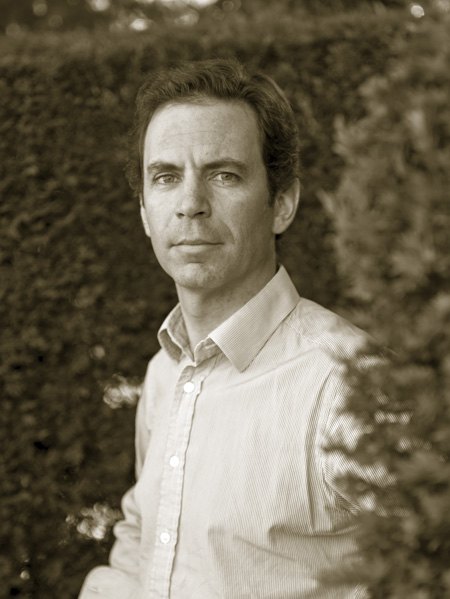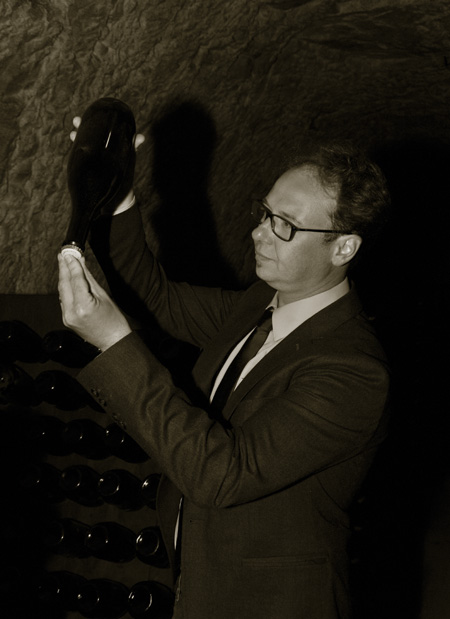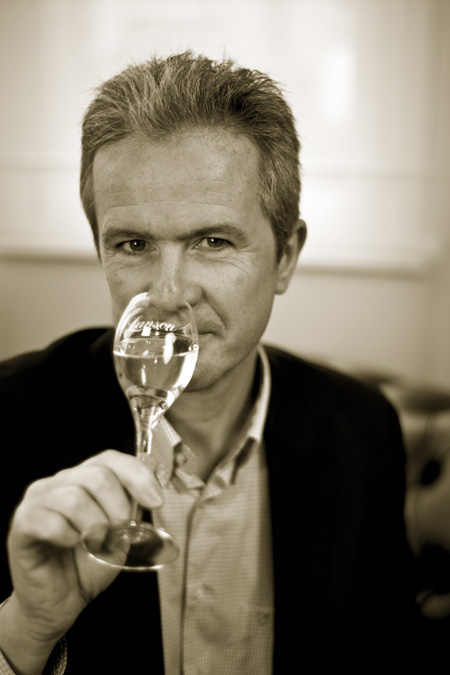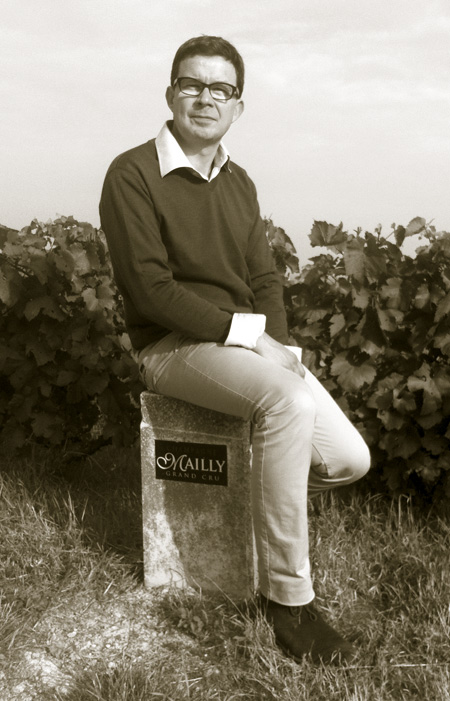Champagne The newcomers
in the Champagne region
the forty-years-old move …
July 2014, Joseph Henriot entrusts his son Thomas with the general management of the eponymous house; Thomas has worked within the group in Burgundy before settling in Pierry. October 2014, Stéphane Dalgac, 51, has been appointed Chairman of the board of directors of Laurent Perrier by the supervisory board. Whereas on the cellar master side, all are native from the region, with a perfect mastery of the profession. At forty years old, they take their destiny in hands, change Champagne house and accept higher responsabilities.
HOUSE HENRIOT
Thomas Henriot, General Manager
Since more than two centuries, the house Henriot is family-owned and independent. A lineage of talented men and women strives all along their history to build the style Henriot, subtle, ethereal, complex, refined. For the bicentenary of the House, Joseph Henriot offers Thomas, his last son, to join the group. In 2014, he entrusts him with the general management of the house Henriot.
At forty years old, Thomas Henriot settles in Champagne and moves in the house “Les Aulnois” at the foothills of Epernay. He welcomes us here, in this recently bought historical residence with a French garden. He looks at ease, distinguished, very calm, and speaks as if cradling his new life in a low and soft voice. He confides
“he was born in Champagne, vintage 1974”, reminds the walks of his childhood in the vineyard with his father who made him taste the grapes, discover the press, the cellars where he got lost.
About studies, he evokes a degree in biology at Jussieu, then a business and management school in Lyon.
“I wanted to work on the borderline between the living and the market, understand the split between the American world who accepts to manipulate the living material and our Judeo-Christian civilization that refuses it”. As a humanist, Thomas is eager for great ideals but also for wide open spaces. Then comes the time for military service, he goes to Buenos Aires, then works for Lyonnaise des Eaux to raise the population’s awareness about the scarcity and high cost of the water! He discovers new horizons like Patagonia … the crisis in Argentina leads him back France where he enters Saint-Gobain. After having worked in a multinational, he wants to discover a small company, to be in direct touch with the customer, he joins Somater where a woman
“Alix Hubin, general manager, takes him under her wing and learns him everything, and above all to roll his sleeves up …”In 2008 his father Joseph Henriot proposes him to join the group and to perpetuate the tradition of the great French know-hows.
“I started very enthusiastically!
Since then, I worked at three posts: I levelled up Villa Ponciago, a small estate in Burgundy at Fleurie in the North of the Beaujolais region. Two years later, I modernised the distribution tool for the wines and Champagnes of the group, and I prepared the digital development for the direct sales.
Now managing the House Henriot, I apply a strategy of continuity and I rely on a key know-how in Champagne: the crafting of quality wines, with excellent supplies (135 hectares). I am going to strengthen the closeness with viticulture and its environment, as I am very sensitive to the nature worked by men. I wish that the house Henriot becomes the flagship of the family group, while respecting tradition, with a wealth of successful innovations; and that it is recognized as the top place of lifestyle à la française.”For this mountain-dweller born Aquarius “life is to short to be poor”. Getting back to his mother land, for sure he will set all his energy and even determination to craft grand wines!
M.C.B. www.champagne-henriot.com

Thomas Henriot

Jérome Dervin HOUSE JOSEPH PERRIER
Jérôme Dervin, Cellar Master
The Dervin family is a lineage in Châlons-en-Champagne! Since 1943, consecutively, from father to son, four successive generations worked as cellar master at the House Joseph Perrier. Jérôme, 37, arrived in June!
Léon opened the path, Michel succeeded him, then Claude. And since June 2014, Jérôme has taken over the reins from his father who retired.
“My grandfather used to work with the traditional Champagne method and resumed his blends empirically by studying the books of the previous years. My father Claude digitized the ‘process’. I use the immediately legible database as a reflection base in real time.
At Joseph Perrier, the quality of wine has been a constant for several years. With my perfectionist character and my taste for regularity, in the short term I will focus on perpetuating the style of the house’s wines and get more harmony in the production of Champagne. Some cuvées like the Rosé deserve smaller and more frequent disgorgements to gain relish and aromas of red fruits.
On the material side, as from my arrival I removed the cuvées that had become out-of-date. And I coordinated the installation of a new disgorgement chain that will be fitted next week into a new, dry, clear and neat, very tidy room.
On the vinification side, I plan to make a better link between the vineyard and the cellar. The vineyards covered with grass and ploughed for example express differently in the cellar. I have to consider these factors to make excellent wines.”The developement of new cuvées is also in project. In 2015, the house Joseph Perrier will launch a very racy Blanc de Noirs.
Jérôme, heir of a multi-generational knowledge, wants to contribute, in the name of quality. He tackles his new duties to become in turn an emotion creator!
S.V. www.josephperrier.com
HOUSE LANSON
Hervé Dantan, Cellar master
beside Jean-Paul Gandon
Son of a wine grower in the Vitryat area, Hervé Dantan starts at Campus d’Avize, studies enology at the university of Reims and with his diploma in hands goes to work in the United States. When back, he joins Champagne Mailly where he stayed 22 years, before being called in July 2013 by Philippe Baijot, Lanson chairman, to second cellar master Jean-Paul Gandon in a first time then replace him when he retires.
“Mailly Grand Cru has taught me all of the job of cellar master, he explains, the qualitative requirement at every stage of the production, the blending, the history, the style, the will to do better, the team spirit, the particular care Pinot Noir needs… ”Going from Champagne Mailly to Champagne Lanson was natural.
“The universe was the same, only the scale changed, the volume was ten times bigger. The profession of cellar master at Lanson is a bit different. Besides the management of a larger team, I have to deal with the relations with the vineyard, to draft the partnership contracts, organize communication actions with the press …
Jean-Paul Gandon transmitted me his knowledge of the brand, its history, its style. I have a lot of respect for him, he worked forty years in service of the house, he has an incredible memory. For every vintage, he has an anecdote. He made me experience rare moments and I draw my inspiration from his knowledge.
My favourite activity in this post, in view of my origins, is the harvest. I love the activity, the organisation, the birth of a vintage in the cellars. It is exciting to see it appear in the vines, once informed about the acidity, the state of health, the level of sugar.” Until now, Hervé Dantan was an observer beside Jean-Paul Gandon. The 2014 harvest marks an inversion in each one’s role. Jean-Paul Gandon let Hervé Dantan guide the operations while being present. The harvest of Clos Lanson opened the floor for this new organisation. It will give rise to a new cuvée Clos Lanson, jewel of the house, that will be aged in oak barrels!
Does wood enter Lanson?
“Twenty-three wooden tuns (16 of 80 hl and 7 of 45hl) are now within our walls. From this year, they will keep reserve wines, dosage liqueurs …”. The style Lanson is not questionned but the house wants to provide some cuvées with a greater complexity without the woody side of course. Hervé Dantan stresses on the chance he has to arrive at a moment when the House invests a lot in the production tool. A new fermenting cellar with small volumes (55 stainless steel vats with three capacities: 50-75-100 hl) has been installed to receive the 2014 harvest, it will enable a more precise vinification.
Another news, Champagne Lanson renovates its tour circuit … A lot of exciting projects are undertaken here! Hervé Dantan admits
“he fully commits himself”.M.C.B. www.lanson.com

Hervé Dantan
 Sébastien Moncuit
Sébastien Moncuit Champagne Mailly Grand Cru
Sébastien Moncuit, Cellar Master
After ten years at Château Malakoff managing a big production, three years spent in a laboratory counselling wine growers and merchants, Sébastien Moncuit, son and grandson of a Champagne wine grower, joined last year Champagne Mailly Grand Cru,
“a fantastic domain of Pinot Noirs that offers a huge scope of opportunities”!Mailly Grand Cru represents 73 hectares planted by 3/4 with Pinot Noirs, and 1/4 of Chardonnay. “Our wine growers supply to Champagne Mailly grapes of beautiful quality to make the Brut Réserve, symbol of the house”, and a full range of 9 cuvées focusing on Pinot Noir called Les Echansons, Intemporelles, Blanc de Noirs ...
“What really interests me in this function, Sébastien tells, is the incredible policy to apply in the vineyard and the terroir to pursue the work of precision implemented by my predecessor. Admittedly the range is fully coherent as all the grapes stem from the same terroir. But to make the vinification by plot more acute, I have to get to know the terroir. To succeed, for six months, I have been identifying and registering 730 plots, shared out over 35 localities. For each of them I have to know the history, the farming method, the actions, but also their specific exposure. Like in Burgundy, I am going to define kind of ‘climats’ that will provide a great diversity to the wines.
This work of by-plot knowledge will enable me to follow up the ripeness of the grapes and to precisely determine the date of harvest. But also to craft cuvées with all the necessary information and to better understand their development. I have to keep informed about the upstream work to adapt the vinifications according to the year. For example, all Mailly wines, including the vintages, undergo malolactic fermentation. If one year I get very ripe grapes and wines with a good structure, I can decide to block this last fermentation on 10% of the cuvée to give extra freshness to the vintage. We also carry out tests for organic vinification with plots farmed according to this practice, and crafting without sulphur. The mastery of these techniques enable to meet the expectations of the customers and to know the impact on the expression of our wines.”This by-plot work is undertaken on a long term basis in order to get a sustainable viticulture certification with our wine growers; on the short term, to give extra pleasure to the wine lovers and bring a complexer expression for the connoisseurs.
For the end of the year, Champagne Mailly Grand Cru proposes
Magnum Collection, four vintages of the last century: 96, tonic; 97, delicate; 98, rich, and 1999 precise, salty and lively after swirling. They are presented individually in an artisanal solid oak case, a beautiful idea to remember for a gift to enter at Christmas in the universe of great Champagnes!
Marie-Caroline Bourrellis
www.champagne-mailly.com



